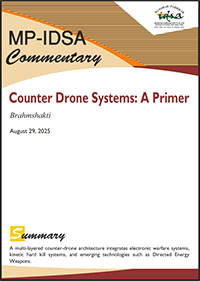Counter Drone Systems: A Primer
- August 29, 2025 |
- IDSA Comments
Introduction
Unmanned Aerial Vehicles (UAVs) like low-cost small drones, quadcopters and loitering munitions have redefined tactical operations, especially in grey zone conflicts. Their advantage lies in being inexpensive, hard to detect, and capable of providing real-time intelligence or delivering kinetic effects. These systems challenge the traditional notions of airspace sovereignty by flying low, exploiting radar blind spots, and often using autonomous navigation to bypass electronic defence systems. Their potential to overwhelm in swarms further complicates traditional responses. A drone costing a fraction of a high-value air defence system can pose a serious threat, not through brute force, but strategic attrition and asymmetry.[1]
As this threat continues to evolve, so must the response. The answer lies in counter-drone systems, or counter-unmanned aerial systems (CUAS), comprising technologies and protocols designed to detect, identify, track and neutralise hostile drones before they can accomplish their mission. Unlike legacy air defence systems optimised for large, fast-moving aircraft or missiles, CUAS platforms are tailored for small, low-flying drones that evade radar and operate with minimal electromagnetic signature. Their relevance is no longer theoretical; the operational question now is not whether, but how fast these systems can be deployed, integrated and adapted.
India has not remained untouched by this shift. Operation Sindoor showed the growing utility of UAVs in combined arms threat frameworks. Before this military operation, along both the western and northern frontiers of India, the frequency of drone intrusions had been rising steadily. While earlier incursions primarily involved GPS-guided quadcopters for smuggling or reconnaissance, recent patterns suggest more sophisticated deployments, often with hostile intent.[2]
Across global battlefields and border zones, counter-drone technologies have evolved around three complementary pillars—electronic warfare (EW), hard-kill interceptors and directed energy weapons (DEWs). These components form a layered matrix, compensating for one another’s limitations in detection, response time and cost-efficiency.[3]
Electronic Warfare
Electronic Warfare remains the most commonly deployed first-response mechanism. These encompass various systems comprising Radio Frequency (RF) jamming, Electro-Optics/Infra-Red (EO/IR) sensors and GPS spoofing to detect and jam hostile drones. However, the increasing use of autonomous drones, pre-programmed to fly via inertial navigation systems rather than radio links, has rendered traditional jamming less effective. Ukraine’s battlefield has made this transition visible, with Russian First-Person View (FPV) drones continuing their missions even in high-jamming environments.[4]
India is witnessing a similar shift. Since 2022, there has been a rise in autonomous drones, especially in the Punjab and Jammu sectors, which require non-RF dependent detection and neutralisation.[5] During Operation Sindoor, Pakistan launched a large-scale drone offensive across India’s western and northern borders. Intelligence and debris analysis indicated the deployment of over 600 drones, including Turkish-origin Songarand BayraktarTB2 UAVs and Chinese-built YIHA armed drones, used for surveillance, loitering attacks and swarm assaults.[6]
In response, India activated its multi-layered air defence and counter-UAS grid, which included the Akashteer Integrated Air Defence Control System (IADCS) developed by Bharat Electronics Limited and mobile vehicle-mounted C-UAS platforms jointly developed by Defence Research and Development Organisation (DRDO) and Adani Defence. These platforms have active electronically scanned array (AESA) radar, RF jammers, EO sensors and a high-energy laser for hard kill.[7] These systems, manufactured indigenously and already inducted by the Border Security Force and Army, effectively intercepted and neutralised the incoming drone swarms with high precision. But as drone threats grow in swarms and sophistication, EW-only approaches are no longer sufficient.
Hard Kill Interceptors
Hard kill interceptors include rapid-fire guns, interceptor drones and precision-guided munitions. Australia’s EOS Slinger, a 30 mm automated cannon system, has been exported to Ukraine.[8] Ukrainian forces have also relied on modified anti-aircraft guns mounted on mobile platforms to engage low-flying drones.
India’s comparable answer is Bhargavastra, a joint project between Solar Industries and Z-Motion Technologies. Bhargavastra deploys unguided salvos to break up drone swarms and guided micro-missiles to neutralise individual UAVs within a 2.5 km envelope. It is compact, modular, and designed for mobile units and sensitive static perimeters.[9]
The use of drones to intercept other drones, so-called drone-on-drone warfare, is also being explored. In India, DRDO and start-ups like NewSpaceResearch are developing autonomous interceptors capable of mid-air engagements.[10] While operational success is still some years away, this technology marks the beginning of a self-learning aerial defence layer, capable of evolving with adversarial tactics.
Directed Energy Weapons
Perhaps the most promising C-UAS defence frontier is developing Directed Energy Weapons (DEWs), including high-powered lasers and microwave systems. These platforms neutralise drones by burning through their structures, optics or control systems. Unlike hard-kill systems, DEWs offer near-infinite engagement capacity, stealth and fractional cost per shot.[11]
Israel’s Iron Beam was reported to have intercepted up to 40 drones during the 2024 Gaza conflict at a cost of approximately US$ 3 per engagement, marking the first strategic-scale deployment of laser weapons.[12] The United Kingdom’s DragonFirelaser, capable of hitting a target equivalent to a £1 coin at 1km and operating at about £10 per shot, successfully engaged aerial targets in trials.[13] During British Army tests, the RapidDestroyer microwave-based system (an RF-DEW) neutralised drone swarms at roughly £0.10 per shot.[14]
India has progressed steadily with its own DEW efforts. DRDO’s Laser Science and Technology Centre (LASTEC), in partnership with Centre for High Energy Systems and Sciences (CHESS), has been developing two laser variants: the Mk-1 (≈10kW, ~1km) and the Mk-2A (≈30kW, ~5km). The Mk-2A, mounted on all-terrain platforms, was successfully tested at Kurnool, Andhra Pradesh, on 13 April 2025 and is now being evaluated for deployment at airbases, nuclear facilities and forward operating bases.[15]
As DEWs mature, countries are moving beyond fixed-base deployment. From mobile truck-mounted systems in India to naval laser prototypes in the US and combat-field trials in the UK and Israel, there’s a growing recognition that DEWs must be modular, rapidly deployable and terrain-adaptable. This global evolution reflects a broader shift in approach—counter-drone technologies must be cost-efficient, autonomous and seamlessly integrated into existing command-and-control architectures.
Conclusion
The rapid evolution of unmanned aerial systems has redefined the nature of threats and the scope of national security responses. In this new battlespace, the challenge is not merely to intercept airborne threats but to outpace them technologically and operationally. The widespread use of low-cost, agile drones for surveillance, smuggling, sabotage and targeted strikes has made them a staple of asymmetric warfare. From battle fronts in Ukraine and Gaza to borders in Punjab and Jammu, the ubiquity of drones has highlighted critical vulnerabilities in traditional air defence systems.
The global response increasingly relies on a multi-layered counter-drone architecture integrating electronic warfare, kinetic systems and emerging technologies, DEWs. Among these, DEWs have shown the most disruptive potential. Their near-zero cost per shot, rapid engagement cycle and stealth characteristics make them well-suited for the scale and unpredictability of drone threats. Whether Israel’s Iron Beam, the UK’s DragonFire, or India’s Mk-2A laser platform, countries are converging towards a future where DEWs will form the backbone of agile and adaptive aerial defence systems.
However, there is a requirement for sustained R&D investment, cross-agency coordination and tailored deployment strategies that reflect regional terrains and threat profiles. India’s focus on indigenous solutions and mobile DEW testing points to this shift, but broader operational integration is still a work in progress. Ultimately, the fight against rogue drones is not a one-time catch-up race but an ongoing innovation contest. The states that will prevail are those that treat C-UAS capabilities not as reactive measures but as proactive instruments of strategic deterrence—modular, scalable and ready for the drone-dominated battlefields of tomorrow.
[1] “CDS Gen Anil Chauhan Highlights the Need for Developing Holistic Counter UAS System for the Armed Forces”, Press Information Bureau, Ministry of Defence, Government of India, 10 March 2025.
[2] “BSF in Punjab Intercepts 13 Drones in a Week, 181 Drones Seized in 2024 Amid Rising Smuggling Concerns”, The New Indian Express, 30 October 2024.
[3] “Anti-Drone | Counter Drone Technology”, skyCTRL.
[4] Kateryna Bondar, “Ukraine’s Future Vision and Current Capabilities for Waging AI-Enabled Autonomous Warfare”, Center for Strategic and International Studies (CSIS), 6 March 2025.
[5] Sameer Patil and Raj Arora, “Countering Hostile Drone Activity on the India-Pakistan Border”, Observer Research Foundation (ORF), 8 May 2023.
[6] Sakshi Tiwari, “Turkey’s TB2 ‘Battles’ Israel’s Heron-2 Drone For Japan’s Military Deal; Which UAV Is Best Suited To Check China?”, The EurAsian Times, 24 August 2025.
[7] Squadron Leader Sriram Rajan, “CUAS and Air Defence Triumph in Operation Sindoor”, Centre for Air Power Studies (CAPS), 4 June 2025.
[8] “EOS Confirms First Slinger Exports to Ukraine”, Australian Industry & Defence Network (AIDN), 2 August 2023.
[9] “India’s Homegrown Bhargavastra Counter-Swarm Drone System Test-Fired Successfully”, The Hindu, 13 May 2025.
[10] Raghav Patel, “NewSpace and DRDO Develop Groundbreaking Autonomous Drone for Indoor Exploration”, Defence News India, 22 June 2024.
[11] Bonnie Johnson et al., “Counter Directed Energy Weapons and the Defense of Naval Unmanned Aerial Vehicles”, Journal of Directed Energy, Vol. 7, No. 2, Winter 2023, pp. 163–182.
[12] Elliott Abrams, “Israel’s Laser Air Defense Revolution”, Council on Foreign Relations (CFR), 1 June 2025.
[13] “UK Says Its High-Power Laser Weapon ‘DragonFire’ Can Hit a Coin a Kilometre Away”, Hindustan Times, 12 March 2024.
[14] “British Soldiers Take Down Drone Swarm in Groundbreaking Use of Radio‑Wave Weapon”, Ministry of Defence, UK, 17 April 2025.
[15] “DRDO News – 17 April 2025”, Defence Research and Development Organisation (DRDO), 17 April 2025.






